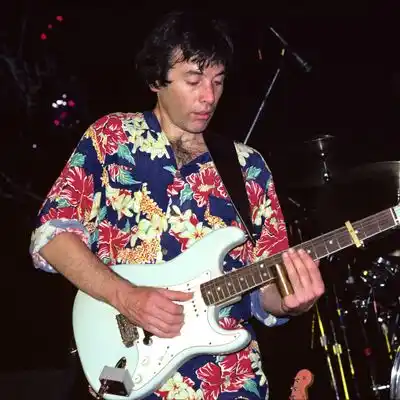
Ry Cooder – The Groovy Maestro and His Guitars
Ry Cooder is a master multi-instrumentalist, a genius composer, and a top-notch record producer.
So, let’s swoop into his life and extraordinary musical journey.
Table of Contents
Life and Career
Ryland Peter Cooder was born on March 15, 1947, and showed signs of musical genius from his early years. He was that kid who would pick up instruments and play them as if he spoke their language. It’s no wonder he was fiddling with the guitar strings at the tender age of three!
His early exposure to blues, folk, and jazz profoundly influenced his musical direction. By his teens, Cooder was already a proficient guitarist, known for his slide guitar technique, which would become a hallmark of his sound.
In the 1960s, Cooder’s career began to take shape. He joined the blues-rock band Captain Beefheart and His Magic Band, playing on their debut album, “Safe as Milk,” in 1967. However, his time with Captain Beefheart was short-lived, as Cooder’s interests leaned more towards exploring different musical styles and traditions.
Throughout the late 1960s and early 1970s, Cooder worked as a session musician, contributing to recordings by The Rolling Stones (notably playing on “Let It Bleed” and “Sticky Fingers”), Randy Newman, and Paul Revere & the Raiders, among others. His reputation as a versatile and skilled guitarist grew, leading to collaborations with a wide range of artists across various genres.
Cooder’s solo career took off in 1970, with his debut album, “Ry Cooder.” This album showcased his eclectic style, blending elements of folk, blues, and gospel.
Over the following decades, he released numerous albums, such as “Into the Purple Valley” (1972), “Paradise and Lunch” (1974), and “Bop till You Drop” (1979), the first major label album recorded digitally.
His music often featured traditional, forgotten, or little-known songs, reinterpreted in his unique style.
Signature Style
Cooder’s style is a blend of so many flavors! We’re talking blues, folk, rock, and more. He was pivotal in bringing genres like Tex-Mex, Hawaiian, and American roots music to a wider audience. His unique style of playing the guitar, especially the slide guitar, has earned him a place amongst the greatest.
Diving a bit into the technical aspect, Cooder’s approach to music is meticulous and innovative. He uses open tunings and employs a fingerpicking style, producing tunes that are distinctively his.
As for influences and teachers, Ry Cooder has drawn inspiration from a broad spectrum of musicians, including blues legends like Blind Willie Johnson and folk musicians such as Woody Guthrie. He has not only learned from the recordings of these and other musicians but also collaborated with many artists from various musical traditions around the world.
The Landmark Albums
1. Ry Cooder (1970)
Ry Cooder’s self-titled debut album was released in 1970, introducing listeners to his interpretation of roots music. This album features a mix of covers and traditional songs.
- Key Tracks: “Alimony,” “Dark is the Night.”
2. Into the Purple Valley (1972)
Released in 1972, “Into the Purple Valley” is one of Cooder’s most celebrated albums, offering a mix of blues, country, and folk music.
- Key Tracks: “Boomer’s Story,” “How Can You Keep Moving (Unless You Migrate Too).”
3. Paradise and Lunch (1974)
“Paradise and Lunch” was released in 1974 and is often cited as one of Cooder’s best albums. It includes a diverse selection of songs, ranging from jazz to blues to gospel.
- Key Tracks: “Tamp ‘Em Up Solid,” “Jesus on the Mainline.”
4. Bop Till You Drop (1979)
“Bop Till You Drop” came out in 1979 and has the distinction of being the first major pop album recorded digitally. This album features a collection of R&B and soul covers, and its production quality and Cooder’s interpretations of these classics were highly praised.
- Key Tracks: “Little Sister,” “I Think It’s Going to Work Out Fine.”
5. Buena Vista Social Club (1997)
Though not a solo album, the “Buena Vista Social Club” project is one of Cooder’s most significant contributions to music. Released in 1997, the album was a collaboration with traditional Cuban musicians.
In 1996, Cooder traveled to Cuba to record with traditional Cuban musicians, including Compay Segundo, Rubén González, and Ibrahim Ferrer. The resulting album was a global success, reviving interest in Cuban music and earning Cooder a Grammy Award.
- Key Tracks: “Chan Chan,” “El Cuarto de Tula.”
Guitars and Equipment
Did you know Cooder is a major collector of vintage guitars? Ry loves his instruments and has an impressive collection to boast about.
Among these, three were acquired from Mike Seeger, a musician known for his deep roots in American folk and traditional music. These instruments are notable not just for their vintage quality but also for their connection to notable musicians and their appearance in music history.
And here’s a quirky one: he scored his first record deal thanks to his flair for the mandolin!
1967 Fender Stratocaster
One of Cooder’s most famous guitars is a 1967 Fender Stratocaster, known for its distinctive “Coodercaster” setup. This guitar has been modified with a combination of a Danelectro neck pickup and a Gibson PAF (Patent Applied For) humbucker in the bridge position. The modifications give the guitar a unique sound that blends different tonal characteristics, making it ideal for slide guitar playing and for achieving Cooder’s signature sound.
Bottleneck Slide Guitar
Cooder has also been known to play a variety of other instruments, including the bottleneck slide guitar, which he often plays in open tunings. His slide technique and choice of open tunings are influenced by traditional American blues and folk music.
1929 Martin 000-28 Guitar
Martin guitars are famed for their rich tone and superior build quality, and the 000-28 model from 1929 is no exception. This guitar represents the golden era of Martin craftsmanship with its exquisite tonewoods and craftsmanship. It is well-suited for fingerstyle playing and has been a favored instrument among blues and folk musicians for decades.
1926 Gibson F-5 Mandolin
This particular instrument was previously owned by Bill Napier, a notable figure in the history of bluegrass music. The Gibson F-5 mandolin, designed by Lloyd Loar, is renowned for its exceptional sound quality and craftsmanship. This mandolin is featured in the Fretboard Journal #32. The F-5 from this era is particularly prized for its sound, making it a valuable piece for collectors and players alike.
Gibson Style 6 Granada Banjo
This instrument, along with the Gibson F-5 mandolin, features matching diamond block inlays, making them a visually distinctive pair. The Style 6 Granada is known for its exceptional tone and was a high-end model in the Gibson banjo line. Banjos from this era are highly sought after by collectors and players for their historic significance and their unparalleled sound quality.
Equipment
Demeter TRM-1 Tremulatorz: This pedal is designed to replicate the tremolo effect of vintage Fender amplifiers, offering a smooth, buttery tremolo. The TRM-1 Tremulator is known for its exceptional sound quality and its ability to integrate seamlessly into a wide range of musical styles. Ry Cooder has used this pedal to great effect, adding depth and texture to his music.
Fender Amps: He is known for his preference for old Fender Tube amps, which complement his playing style and add warmth to his tone.
The Legacy and Influence
Even after decades in the music industry, Ry Cooder continues to evolve and experiment. What makes Cooder really special is his enduring influence on musicians around the world. Artists from various genres cite him as an inspiration, absorbing his innovative musical fusions and rendering in their compositions.
But Ry Cooder isn’t just about the tunes. He’s known for his humanitarian efforts and his commitment to social and political causes.
Away from the limelight, Ry is a loving husband and a father. His son, Joachim Cooder, is a talented drummer and composer. Ry often collaborates with Joachim, creating beautiful symphonies together.
